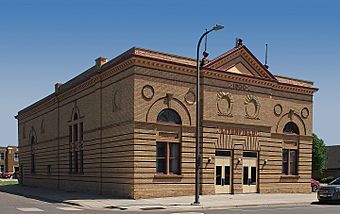Litchfield Opera House facts for kids
Quick facts for kids |
|
|
Litchfield Opera House
|
|

The Litchfield Opera House from the northwest
|
|
| Location | 126 N. Marshall Ave., Litchfield, Minnesota |
|---|---|
| Area | less than one acre |
| Built | 1900 |
| Built by | N.P. Franzen |
| Architect | W.T. Towner |
| Architectural style | Renaissance |
| NRHP reference No. | 84000019 |
| Added to NRHP | October 4, 1984 |
The Litchfield Opera House is a special community building in Litchfield, Minnesota, USA. It's listed on the National Register of Historic Places because it's very important to the town's history.
In 1899, a group of business people decided to create a new place. They wanted a building where people could hold meetings and enjoy plays. The old town hall, built in 1871, was too old and not useful anymore. The local government, called Litchfield Township, paid for the new building. An architect named W.T. Towner designed it, and N.P. Franzen built it. The city of Litchfield bought the building from the township in 1911. The Litchfield Opera House was officially added to the National Register of Historic Places in 1983.
Contents
Building Design and Early Days
The Litchfield Opera House is a great example of Renaissance Revival architecture. This style looks back to the beautiful buildings of the Renaissance period. It's quite rare to see this type of building in Litchfield or Meeker County.
What the Building Looks Like
Most of the outside walls are made of yellow clay brick. These bricks were made right there in Litchfield. The building also has red bricks and red terra cotta patterns. Terra cotta is a type of baked clay used for decoration. These details make the building look very grand and unique.
Opening Night and First Uses
The opera house first opened its doors on November 8, 1900. The very first performance was a play called "The Marble Heart." A famous actor named William Owen starred in it. Besides plays and operas, the building was used for many other important things. It hosted town meetings, elections, and even military recruitment events. It was a central spot for government activities.
Changes Over Time
The Litchfield Opera House has changed its purpose many times over the years. It started as a place for entertainment and public gatherings.
Becoming City Offices
Sometime between 1930 and 1939, the inside of the building was updated. It was changed to be used as city offices. By 1983, when it was nominated for the National Register, it housed many different groups. City offices and other community organizations used the rooms. Senior citizens, the Girl Scouts, and community education programs also met there. Even the Litchfield Police Department had some rooms in the building.
Moving Out and New Plans
In 2002, the city offices moved out of the opera house. They had to move because mold was found inside the building. The city moved its offices into temporary trailers in the parking lot. A new city hall was completed in 2006. However, the future of the old opera house building was still uncertain for a few years.
A New Chapter for the Opera House
In 2008, the city sold the building to a group called the Greater Litchfield Opera House Association, Inc. They bought it for $100,000. The city accepted a special payment of one 1900 silver dollar. The agreement stated that the rest of the money would be used to fix up the building. This way, it could be used by the community again.
Restoration and Community Use
After 2008, a lot of work went into restoring the Litchfield Opera House. This was a big project to bring the historic building back to life.
How the Building Was Restored
Between 2008 and 2023, many parts of the building were repaired. The roof was fixed, and the brickwork was restored. New windows were put in, and the inside of the building was made beautiful again. This work was possible thanks to grants from the Minnesota Historical Society. These grants came from the 2008 Clean Water, Land, and Legacy Amendment. This amendment helps protect Minnesota's natural and cultural heritage.
Renting the Opera House Today
Today, the Litchfield Opera House is a vibrant community space once more. It is available for people to rent for many different events. You can hold parties, weddings, dinners, funerals, and other personal gatherings there. It continues to be an important part of Litchfield's community life.
Gallery





